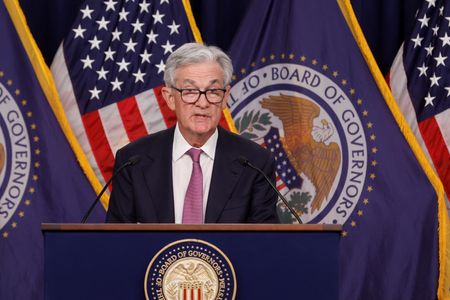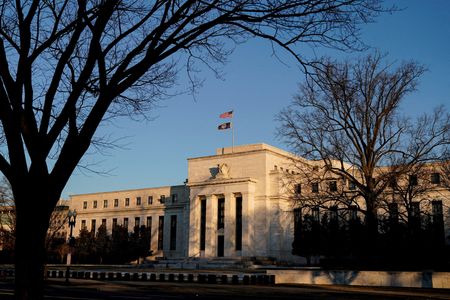By Howard Schneider and Ann Saphir
WASHINGTON (Reuters) -The Federal Reserve said on Wednesday it had turned a key corner in the fight against high inflation, but that “victory” would still require its benchmark overnight interest rate to be increased further and remain elevated at least through 2023.
In announcing its latest policy decision, the U.S. central bank scaled back to a quarter-percentage-point rate increase after a year of larger hikes and swept aside in its statement the long list of reasons, from war to the pandemic, that were driving prices higher to say simply that “inflation has eased.”
Yet policymakers also projected “ongoing increases” in borrowing costs would be needed, a still open-ended commitment that did not yet pinpoint when the rate hikes might stop, and pushed back against an expectation in financial markets that the Fed would pause soon and, indeed, cut rates later this year.
Investors nevertheless took a dovish cue from remarks by Fed Chair Jerome Powell, who referred repeatedly during a news conference to the “disinflationary” process that now appeared to be underway. Equity markets rose as Powell spoke and investors slightly boosted bets for coming rate cuts.
Meanwhile, Powell insisted that rate cuts are not in the offing, and took pains to walk what has become an increasingly fine line between the flow of data showing inflation in steady decline with the need to keep the public and investors attuned to the fact that interest rates will continue rising.
“We can now say for the first time that the disinflationary process has started,” Powell told reporters after the end of the Fed’s latest two-day policy meeting, with goods prices slowing, pandemic-related shortages easing, and supply chains getting back to normal. “This is a good thing.”
‘EARLY STAGES’
From a peak of nearly 7% in June, the Fed’s preferred measure of inflation was 5% in December, still well above its 2% target but heading steadily in the right direction.
Yet “it’s just the early stages,” Powell said. “We’re going to be cautious about declaring victory and … sending signals that we think that the game is won, because we’ve got a long way to go.”
Important segments of the economy, including broad swaths of the service sector, have yet to see inflation slow, the Fed chief said, while a high level of job openings and still-strong wage increases showed the labor market was “extremely tight.”
“The labor market continues to be out of balance,” Powell said, flagging the fact that Fed officials feel it is likely that the unemployment rate will need to rise from its current low level of 3.5% for inflation to complete the journey back to the 2% level.
The Fed’s statement on Wednesday marked its first explicit acknowledgment of slowing inflation after a year in which prices accelerated much faster than anticipated – requiring a series of rapid three-quarters-of-a-percentage point and half-percentage-point rate increases to match the outbreak of rising prices.
Dynamics that the Fed during the past year has said were driving prices higher, including the pandemic, were either dropped from the statement altogether or, in the case of the war in Ukraine, cited only as a source of “global uncertainty” rather than inflation.
The rate hikes imposed by the Fed since March have now totaled 4.5 percentage points, with the policy rate now in a range between 4.50% and 4.75%, the highest since 2007. That is reflected in an array of consumer borrowing costs from home mortgages to car loans.
The full impact of that monetary policy tightening has yet to be felt in the economy, but has so far been absorbed without derailing the “modest” economic growth and “robust” job gains that the Fed cited in its latest statement.
It is in part that resilience that has the central bank poised for “ongoing increases” in its policy interest rate.
With inflation still high and demand in the economy stronger than many anticipated, Powell said it remains unclear just how much higher rates will need to go. As of December, Fed policymakers projected a peak policy rate in a range between 5.00% and 5.25%, consistent with what Powell said, as an aside during his news conference, were likely a “couple” more rate hikes to come.
Stocks, modestly lower ahead of the Fed rate decision, turned sharply higher as Powell spoke. The benchmark S&P 500 index ended the day with just over a 1% gain.
At the same time, the yield on the 2-year Treasury note, the maturity most sensitive to Fed policy expectations, dropped abruptly and traded down more than 10 basis points at 4.10%. The U.S. dollar slid against a basket of major trading partner currencies.
“If you were hoping for clear signs of an upcoming pause in interest rate hikes, you were left wanting. The Federal Reserve retained the phrase ‘ongoing increases’ in their statement, leaving their options open depending on what upcoming economic data says,” said Greg McBride, chief financial analyst at Bankrate.
INFLATION TARGET REAFFIRMED
The Fed statement indicated that any future rate increases would be in quarter-percentage-point increments, dropping a reference to the “pace” of future increases and instead referring to the “extent” of rate changes.
Fed policymakers hope the central bank can continue nudging inflation lower without triggering a deep recession or causing a substantial rise in unemployment.
The Fed did not issue new economic projections from its policymakers on Wednesday, but did reaffirm its commitment to its 2% average inflation target as part of its annual review of operating principles.
(Reporting by Howard Schneider; Additional reporting by Ann Saphir and Michael S. Derby; Editing by Paul Simao)




